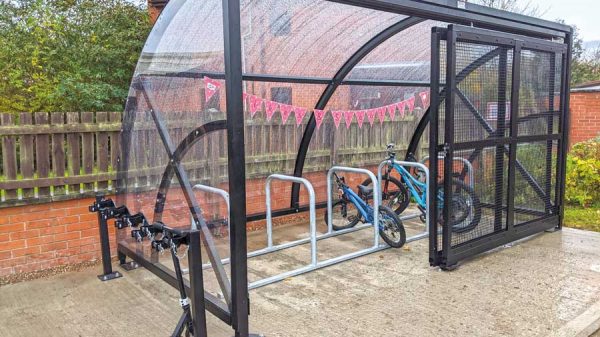Toxic garden created for MORE TH>N’s new campaign to raise awareness of the dangers of pets being poisoned by common household plants and flowers.
One in three pet owners (31%) admits they have no idea if the plants and flowers in their gardens are toxic to pets.
MORE TH>N is calling on plant producers and manufacturers of garden products to provide clearer labelling on the toxicity of plants for cats and dogs.
Open to visitors at the Horniman Museum & Gardens until 14 June 2015. Strictly no cats, dogs or pets of any kind allowed in!
For humans it’s a stunning show garden and a place of quiet serenity. For cats and dogs, however, it’s a certified death trap. That’s because The MORE TH>N Poisonous Pawtanical Garden is the world’s most poisonous garden to pets.
The garden, launched today, is part of the insurer’s new campaign to raise awareness of the issue of cats and dogs being poisoned by common household plants and flowers – particularly timely given that pets are likely to spend more time outdoors over the next few months due to improving weather.
According to research by MORE TH>N with 2,000 cat and dog owners[1] 8% of canines and felines in Britain have ingested poisonous plants or flowers. Of those, 43% subsequently needed urgent veterinary care, while 15% sadly passed away.
The MORE TH>N Poisonous Pawtanical Garden is based at London’s Horniman Museum & Gardens as part of this year’s Chelsea Fringe garden festival. It houses over 30 varieties* of plants and flowers that may look beautiful, but if ingested by cats and dogs are at best likely to result in an upset tummy and at worst lead to death.
Far from being rare and exotic botanical specimens, all of the plants and flowers in The MORE TH>N Poisonous Pawtanical Garden can be found in any home garden, public park or horticultural centre in Britain. A few of the plants on show include: Begonia, Buxus Pyramiden, Chrysanthemum, Clematis, Cordyline, Daisy, Dahlia, Elderberry, Foxglove, Grape plant, Hydrangea, Hedera Ivy, Lilies (variety), Cherry Laurel, Marigold, Nerium Oleander, Paeonia mix, Papaver Poppy, Tomato plant and Wisteria.
In addition to raising general awareness of this issue, MORE TH>N is directly campaigning for plant producers, manufacturers of garden products and retailers to provide clearer labelling signalling if their items are safe or harmful to cats and dogs – something that 86% of cat and dog owners would like to see. For more information on this campaign petition please visit www.morethan.com/pet-insurance/news/most-poisonous-garden.
Phil Wilson-Brown, Managing Director of MORE TH>N Insurance, commented: “The MORE TH>N Poisonous Pawtanical Garden allows us to raise awareness of the dangers of plants that are poisonous to cats and dogs in an imaginative and memorable way. However, our new campaign is also about taking direct and immediate action – by both urging suppliers and retailers of garden plants and flowers to provide clear ‘pet safe’ labelling, while also better educating pet owners on the issue.
“Through this campaign we’ll be arming pet owners with the practical advice and information they need to identify safe and dangerous plants, to recognise the symptoms of poisoning – and what to do in that eventuality – and above all to reduce the likelihood of their beloved pets becoming ill in the first place.”
Despite the clear and present dangers, there is a widespread ignorance of the perils gardens pose to animals, with one in every three pet owners (31%) polled by MORE TH>N admitting they have no idea if the plants and flowers in their gardens are toxic. The same number were unaware that plants could be poisonous to pets, while 71% of all pet owners cannot identify any of the symptoms of poisoning in their cat or dog.
Perhaps even more concerning is the finding that nearly half (44%) of pet owners are not only aware that their garden houses poisonous plants, but are prepared to risk their cat or dog won’t eat them so they can have a pretty garden.
The MORE TH>N Poisonous Pawtanical Garden has been designed in collaboration with the insurer, veterinarian Robert White-Adams and 2015 RHS Chelsea gold medal-winning garden designer Ian Drummond, of Indoor Garden Design. In addition, the campaign ambassador is TV gardener and dog fan Charlie Dimmock.
Charlie Dimmock commented: “The MORE TH>N Poisonous Pawtanical Garden isn’t about telling pet owners to go around uprooting their flower beds – it’s a way to help them make more informed choices when they design their gardens or buy new plants for their home as well as being more aware of the garden plants they already have.
“There are many plants and flowers that aren’t toxic to pets and we’ll be offering visitors to the garden information and advice on safe plants for pets. With this advice we can hopefully reduce the number of pets that are accidently poisoned while keeping Britain’s gardens colourful and interesting.”
The MORE TH>N Poisonous Pawtanical Garden is open to the public from 10:00am – 5:00pm every day from 5 June – 14 June at Horniman Museum & Gardens, South East London, and is free to enter. Perhaps unsurprisingly, though, only humans are allowed in the garden, with a boundary fence and security preventing any curious canines, wandering felines or pets of any other kind from entering. Pet owners wishing to visit the garden can leave their pets outside the garden in the care of the garden staff.
For further information on The MORE TH>N Poisonous Pawtanical Garden plus details of toxic and non-toxic plants for pets please visit www.morethan.com/pet-insurance/news/most-poisonous-garden.
Pet owners can also win free pet friendly flower seeds via MORE TH>N’s social channels; www.facebook.com/morethan and www.twitter.com/morethan.







